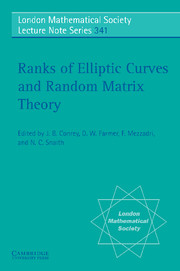Book contents
- Frontmatter
- Contents
- Introduction
- FAMILIES
- Elliptic curves, rank in families and random matrices
- Modeling families of L-functions
- Analytic number theory and ranks of elliptic curves
- The derivative of SO(2N +1) characteristic polynomials and rank 3 elliptic curves
- Function fields and random matrices
- Some applications of symmetric functions theory in random matrix theory
- RANKS OF QUADRATIC TWISTS
- NUMBER FIELDS AND HIGHER TWISTS
- SHIMURA CORRESPONDENCE, AND TWISTS
- GLOBAL STRUCTURE: SHA AND DESCENT
- Index
The derivative of SO(2N +1) characteristic polynomials and rank 3 elliptic curves
Published online by Cambridge University Press: 10 November 2010
- Frontmatter
- Contents
- Introduction
- FAMILIES
- Elliptic curves, rank in families and random matrices
- Modeling families of L-functions
- Analytic number theory and ranks of elliptic curves
- The derivative of SO(2N +1) characteristic polynomials and rank 3 elliptic curves
- Function fields and random matrices
- Some applications of symmetric functions theory in random matrix theory
- RANKS OF QUADRATIC TWISTS
- NUMBER FIELDS AND HIGHER TWISTS
- SHIMURA CORRESPONDENCE, AND TWISTS
- GLOBAL STRUCTURE: SHA AND DESCENT
- Index
Summary
Abstract
We calculate the value distribution of the first derivative of characteristic polynomials of matrices from SO(2N + 1) at the point 1, the symmetry point on the unit circle of the eigenvalues of these matrices. The connection between the values of random matrix characteristic polynomials and values of the L-functions of families of elliptic curves implies that this calculation in random matrix theory is relevant to the problem of predicting the frequency of rank three curves within these families, since the Birch and Swinnerton-Dyer conjecture relates the value of an L-function and its derivatives to the rank of the associated elliptic curve. This article is based on a talk given at the Isaac Newton Institute for Mathematical Sciences during the “Clay Mathematics Institute Special Week on Ranks of Elliptic Curves and Random Matrix Theory”.
Introduction
Random matrix theory and number theory
The connection between random matrix theory and number theory began with the work of Montgomery when he conjectured that the distribution of the complex zeros of the Riemann zeta function follows the same statistics as the eigenvalues of a random matrix chosen from U(N) generated uniformly with respect to Haar measure. This conjecture is supported by numerical evidence and also by further work suggesting that the same conjecture is true for more general L-functions. For all these L-functions there is a Generalized Riemann Hypothesis that the non-trivial zeros lie on a vertical line in the complex plane.
- Type
- Chapter
- Information
- Ranks of Elliptic Curves and Random Matrix Theory , pp. 93 - 108Publisher: Cambridge University PressPrint publication year: 2007

